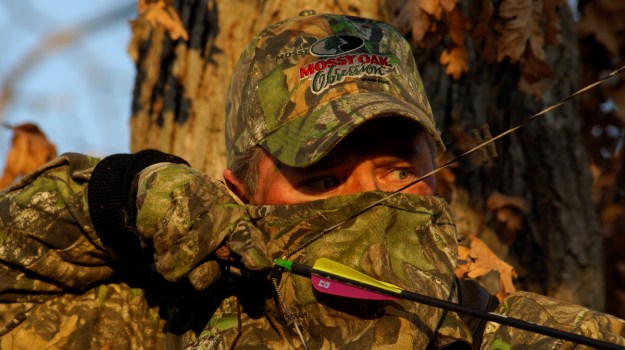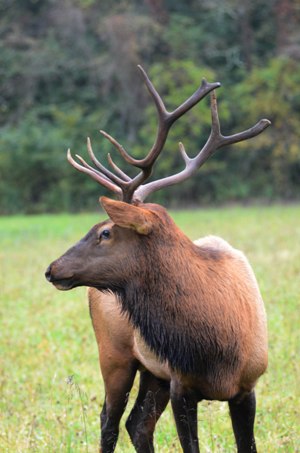
Editor’s Note: Dennis Garrett of Harlan, Kentucky, in the southeastern corner of the state, lives in the Appalachian Mountains and says, “I've worn Mossy Oak from the first time I started hunting. I've been deer hunting since 1998, but my dad took me squirrel hunting with him when I was too small to carry a gun. I like the Mossy Oak Treestand pattern. When the leaves are off the trees in our section of the country, our trees look gray, and then I’ll resemble a part of the tree. During the early hunting season, I like Mossy Oak Infinity.”
Dennis Garrett of Harlan, Kentucky, can hear elk bugling from his tree stand and watch black bears walk under his tree stand where he lives in southeastern Kentucky. He sees 20-different bears so often that he’s practically named them. This 2014-2015 season Garrett is hunting a whitetail that will score in the 170s, but last season he failed to take a deer. A tournament archer as well as a bowhunter, he’s a pure whitetail hunter who has a bow in his hand from mid-September to mid-January.
 Garrett has seen the land and the animals change since bears and elk moved into this region. Often, we fail to realize how hunting can change when a new species is introduced to the land we hunt or migrates in to the land we hunt. For many years, there have been small populations of feral hogs in isolated regions of the United States. Now those feral hogs have become a nuisance in many areas of the country, and there seems to be no way to stop them. Resident Canada geese were stocked into many states where they’d been totally wiped out in years past, but today often have become nuisances, sometimes outnumbering the wild goose population. The wolves in the Northwest were reintroduced. Landowners and hunters organized and put up strong resistance to this reintroduction of a native species. However, western Kentucky seems to be a bright spot for the reintroduction of elk in the eastern part of the United States, and the jury is still out on expanding the black bear population in that same region. Mossy Oak pro Dennis Garrett has learned to live with the bears and the elk and still take whitetails. This year he's hunting the biggest whitetail he's ever seen in his life.
Garrett has seen the land and the animals change since bears and elk moved into this region. Often, we fail to realize how hunting can change when a new species is introduced to the land we hunt or migrates in to the land we hunt. For many years, there have been small populations of feral hogs in isolated regions of the United States. Now those feral hogs have become a nuisance in many areas of the country, and there seems to be no way to stop them. Resident Canada geese were stocked into many states where they’d been totally wiped out in years past, but today often have become nuisances, sometimes outnumbering the wild goose population. The wolves in the Northwest were reintroduced. Landowners and hunters organized and put up strong resistance to this reintroduction of a native species. However, western Kentucky seems to be a bright spot for the reintroduction of elk in the eastern part of the United States, and the jury is still out on expanding the black bear population in that same region. Mossy Oak pro Dennis Garrett has learned to live with the bears and the elk and still take whitetails. This year he's hunting the biggest whitetail he's ever seen in his life.
According to Garrett, “I'm often asked, ‘How did you become a Mossy Oak pro?’ I shoot competitive archery as well as bowhunt. I met Parrish Elliott, a regional supervisor for Mossy Oak in our area, while shooting tournament archery. I filled out an application to become a Mossy Oak Pro Staffer. When I went to the next few tournaments, I told Parrish I had done what he asked me to do. I had filled out my application, but I was denied. What was so funny was that Parrish was the one to whom I sent my application. I knew getting on the Mossy Oak Pro Staff was a long shot, so I didn’t worry about it too much. However, since I’d always worn Mossy Oak, I thought being on the Mossy Oak staff would be cool. Being turned down to be a Mossy Oak pro really didn’t bother me that much, because I knew there was a slim chance of my making it anyway.
“I kept shooting archery tournaments with Parrish and even was the same group with him. After we spent all day shooting in the same group together, I told him, ‘Parrish, I can’t believe you turned me down to be on the Mossy Oak Pro Staff. I did everything you told me to do to get on it.’ A few weeks later I got a call. I was invited to join the Mossy Oak Pro Staff, and I was really excited.”
Day 4: Dennis Garrett Explains That When Bear Move in the Deer Move Out






























